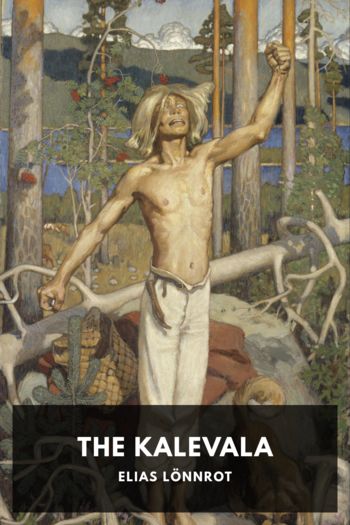The Kalevala, Elias Lönnrot [easy novels to read TXT] 📗

- Author: Elias Lönnrot
Book online «The Kalevala, Elias Lönnrot [easy novels to read TXT] 📗». Author Elias Lönnrot
By
Elias Lönnrot.
Translated by
John Martin Crawford.
This ebook is the product of many hours of hard work by volunteers for Standard Ebooks, and builds on the hard work of other literature lovers made possible by the public domain.
This particular ebook is based on a transcription produced for Project Gutenberg and on digital scans available at the Internet Archive.
The writing and artwork within are believed to be in the U.S. public domain, and Standard Ebooks releases this ebook edition under the terms in the CC0 1.0 Universal Public Domain Dedication. For full license information, see the Uncopyright at the end of this ebook.
Standard Ebooks is a volunteer-driven project that produces ebook editions of public domain literature using modern typography, technology, and editorial standards, and distributes them free of cost. You can download this and other ebooks carefully produced for true book lovers at standardebooks.org.
To
Dr. J. D. Buck,
an encouraging and unselfish friend, and to his affectionate family,
these pages are gratefully inscribed.
The following translation was undertaken from a desire to lay before the English-speaking people the full treasury of epical beauty, folklore, and mythology comprised in the Kalevala, the national epic of the Finns. A brief description of this peculiar people, and of their ethical, linguistic, social, and religious life, seems to be called for here in order that the following poem may be the better understood.
Finland (Finnish, Suomi or Suomenmaa, the swampy region, of which Finland, or Fen-land is said to be a Swedish translation,) is at present a Grand-Duchy in the northwestern part of the Russian empire, bordering on Olenetz, Archangel, Sweden, Norway, and the Baltic Sea, its area being more than 144,000 square miles, and inhabited by some 2,000,000 of people, the last remnants of a race driven back from the East, at a very early day, by advancing tribes. The Finlanders live in a land of marshes and mountains, lakes and rivers, seas, gulfs, islands, and inlets, and they call themselves Suomilainen, Fen-dwellers. The climate is more severe than that of Sweden. The mean yearly temperature in the north is about 27° F, and about 38° F, at Helsingfors, the capital of Finland. In the southern districts the winter is seven months long, and in the northern provinces the sun disappears entirely during the months of December and January.
The inhabitants are strong and hardy, with bright, intelligent faces, high cheekbones, yellow hair in early life, and with brown hair in mature age. With regard to their social habits, morals, and manners, all travellers are unanimous in speaking well of them. Their temper is universally mild; they are slow to anger, and when angry they keep silence. They are happy-hearted, affectionate to one another, and honorable and honest in their dealings with strangers. They are a cleanly people, being much given to the use of vapor-baths. This trait is a conspicuous note of their character from their earliest history to the present day. Often in the runes of the Kalevala reference is made to the “cleansing and healing virtues of the vapors of the heated bathroom.”
The skull of the Finn belongs to the brachycephalic (short-headed) class of Retzius. Indeed the Finn-organization has generally been regarded as Mongol, though Mongol of a modified type. His color is swarthy, and his eyes are gray. He is not inhospitable, but not over-easy of access; nor is he a friend of new fashions. Steady, careful, laborious, he is valuable in the mine, valuable in the field, valuable oil shipboard, and, withal, a brave soldier on land.
The Finns are a very ancient people. It is claimed, too, that they began earlier than any other European nation to collect and preserve their ancient folklore. Tacitus, writing in the very beginning of the second century of the Christian era,





Comments (0)